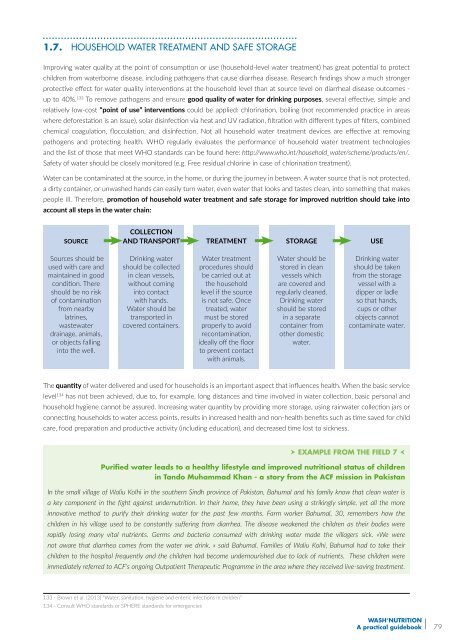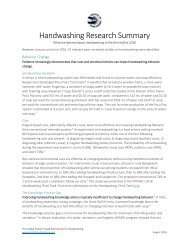WASH’ Nutrition
manuel_wash_nutrition_online
manuel_wash_nutrition_online
You also want an ePaper? Increase the reach of your titles
YUMPU automatically turns print PDFs into web optimized ePapers that Google loves.
1.7. Household water treatment and safe storage<br />
Improving water quality at the point of consumption or use (household-level water treatment) has great potential to protect<br />
children from waterborne disease, including pathogens that cause diarrhea disease. Research findings show a much stronger<br />
protective effect for water quality interventions at the household level than at source level on diarrheal disease outcomes -<br />
up to 40%. 133 To remove pathogens and ensure good quality of water for drinking purposes, several effective, simple and<br />
relatively low-cost “point of use” interventions could be applied: chlorination, boiling (not recommended practice in areas<br />
where deforestation is an issue), solar disinfection via heat and UV radiation, filtration with different types of filters, combined<br />
chemical coagulation, flocculation, and disinfection. Not all household water treatment devices are effective at removing<br />
pathogens and protecting health. WHO regularly evaluates the performance of household water treatment technologies<br />
and the list of those that meet WHO standards can be found here: http://www.who.int/household_water/scheme/products/en/.<br />
Safety of water should be closely monitored (e.g. Free residual chlorine in case of chlorination treatment).<br />
Water can be contaminated at the source, in the home, or during the journey in between. A water source that is not protected,<br />
a dirty container, or unwashed hands can easily turn water, even water that looks and tastes clean, into something that makes<br />
people ill. Therefore, promotion of household water treatment and safe storage for improved nutrition should take into<br />
account all steps in the water chain:<br />
Source<br />
Collection<br />
and transport<br />
Treatment<br />
Storage<br />
Use<br />
Sources should be<br />
used with care and<br />
maintained in good<br />
condition. There<br />
should be no risk<br />
of contamination<br />
from nearby<br />
latrines,<br />
wastewater<br />
drainage, animals,<br />
or objects falling<br />
into the well.<br />
Drinking water<br />
should be collected<br />
in clean vessels,<br />
without coming<br />
into contact<br />
with hands.<br />
Water should be<br />
transported in<br />
covered containers.<br />
Water treatment<br />
procedures should<br />
be carried out at<br />
the household<br />
level if the source<br />
is not safe. Once<br />
treated, water<br />
must be stored<br />
properly to avoid<br />
recontamination,<br />
ideally off the floor<br />
to prevent contact<br />
with animals.<br />
Water should be<br />
stored in clean<br />
vessels which<br />
are covered and<br />
regularly cleaned.<br />
Drinking water<br />
should be stored<br />
in a separate<br />
container from<br />
other domestic<br />
water.<br />
Drinking water<br />
should be taken<br />
from the storage<br />
vessel with a<br />
dipper or ladle<br />
so that hands,<br />
cups or other<br />
objects cannot<br />
contaminate water.<br />
The quantity of water delivered and used for households is an important aspect that influences health. When the basic service<br />
level 134 has not been achieved, due to, for example, long distances and time involved in water collection, basic personal and<br />
household hygiene cannot be assured. Increasing water quantity by providing more storage, using rainwater collection jars or<br />
connecting households to water access points, results in increased health and non-health benefits such as time saved for child<br />
care, food preparation and productive activity (including education), and decreased time lost to sickness.<br />
EXAMPLE FROM THE FIELD 7 <br />
Purified water leads to a healthy lifestyle and improved nutritional status of children<br />
in Tando Muhammad Khan - a story from the ACF mission in Pakistan<br />
In the small village of Waliu Kolhi in the southern Sindh province of Pakistan, Bahumal and his family know that clean water is<br />
a key component in the fight against undernutrition. In their home, they have been using a strikingly simple, yet all the more<br />
innovative method to purify their drinking water for the past few months. Farm worker Bahumal, 30, remembers how the<br />
children in his village used to be constantly suffering from diarrhea. The disease weakened the children as their bodies were<br />
rapidly losing many vital nutrients. Germs and bacteria consumed with drinking water made the villagers sick. «We were<br />
not aware that diarrhea comes from the water we drink. » said Bahumal. Families of Waliu Kolhi, Bahumal had to take their<br />
children to the hospital frequently and the children had become undernourished due to lack of nutrients. These children were<br />
immediately referred to ACF’s ongoing Outpatient Therapeutic Programme in the area where they received live-saving treatment.<br />
133 - Brown et al. (2013) “Water, sanitation, hygiene and enteric infections in children”<br />
134 - Consult WHO standards or SPHERE standards for emergencies<br />
<strong>WASH’</strong><strong>Nutrition</strong><br />
A practical guidebook<br />
79



